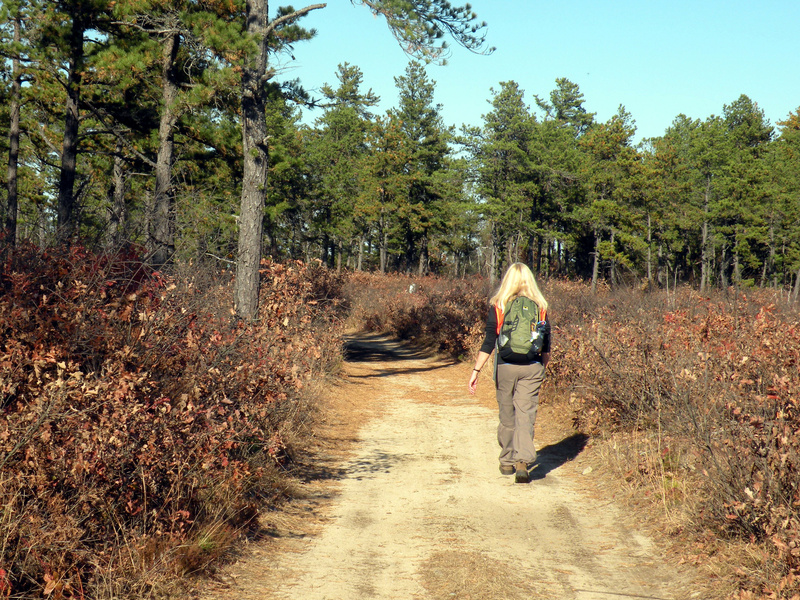The pitch pine-scrub oak forest type is one of the rarest forests in the world. Its generally level topography and sand and gravel soils are favored for development and, as such, less than 1 percent of the original ecotype remains.
The Waterboro Barrens encompass the largest intact pitch pine-scrub oak forest in New England, as well as low-bush blueberries and woodland sedge, unique wetlands, a host of rare insects, plants and bird species, and a healthy population of bear, deer and moose.
The 2,475-acre preserve, located in Waterboro and Shapleigh, is owned and managed by The Nature Conservancy, which has worked to protect more than one million acres in Maine.
“The preserve came about due to a failed development in the late 1980s,” said Parker Schuerman, Southern Maine Preserve Manager for TNC. “The Buff Brook Road was the first road built into the planned development, but before more could be done, the developer went belly up.”
Sometime in the early 1990s The Nature Conservancy purchased the property from the developer and established the preserve.
To find the trail head, first get yourself to Waterboro. Then take West Road for 6 miles to Ross Corner. Turn right on Newfield Road and go a mile to Sherburne Lake Road. Turn right and continue on Bluff Brook Road for nearly a mile. Take a left; the parking area is at the end of the road.
When I visited the barrens with my wife late last fall, there was an old map on a plywood board tacked to a tree. The map was in poor shape and lacked detail, including a “you are here” arrow. Before we struck off I took a photo of it thinking we would eventually be able to orient ourselves, but to no avail. Oh well, we thought, that’s why they call it adventure.
Schuerman assured me a new information kiosk will be erected at the trail head this summer, and a map of the trail network will soon be posted to the TNC Web site. In the meantime, you can call TNC and they’ll happily mail you a map and information.
Miles of fire roads were built to fight the wildfires of 1947; today they serve as pathways through the forest. Many are designated for foot traffic only, while others are for multiple use. linking a series of tracks together you can explore for many miles and hours.
Just beyond the trail head we passed an area that had seen recent prescribed burning, a common forest management and ecological restoration technique used by the conservancy in the barrens.
“We use fire to thin the forest and prevent wildfires,” Schuerman said. “We’re creating space around the borders of the preserve, reducing the fuels that could feed a fire. Fire is also the primary tool for managing the pitch pine-scrub oak barrens.”
Approximately 300 acres are burned each year as part of the fuel and habitat management plan.
Not knowing just where we were headed but determined to explore anyway, we turned onto a wide foot trail and strode forth through the scraggly trees. The trail ended at a stream, which we later figured to be Buff Brook. This was as good a spot as any for lunch, and we sat on the soft forest carpet and munched sandwiches, fruit and granola bars.
Doubling back, we hiked up a ridge and soon found ourselves high above the same stream. Beyond, descending around a bend in the brook with high sand banks, we came to an old dam site.
Buff Brook is a native brook trout fishery, according to Schuerman. An old carriage path — the Thyngs Mill Road — used to traverse this area, serving the mill that once operated here. The dam blew out in 1968.
From the dam site we tried a different path for the return trek, stopping often to listen to the bird life and observe the burned trunks of these fire-dependent trees. Moose, deer and raccoon prints dotted the track. Whippoorwills and nighthawks are common in the barrens, but we saw only chickadees this day.
After three glorious hours of lazy wandering we returned to the car. And even though we didn’t always know exactly where we were in the pine and oak environs of the Waterboro Barrens, it was easy enough to find our way back.
For more information on visiting the Waterboro Barrens, go to www.nature.org/wherewework/northamerica/states/maine/preserves or call 798-1022.
Carey Kish of Bowdoin is a freelance writer and avid hiker. Send comments and hike suggestions to:
MaineOutdoorJournal.com
Send questions/comments to the editors.



Success. Please wait for the page to reload. If the page does not reload within 5 seconds, please refresh the page.
Enter your email and password to access comments.
Hi, to comment on stories you must . This profile is in addition to your subscription and website login.
Already have a commenting profile? .
Invalid username/password.
Please check your email to confirm and complete your registration.
Only subscribers are eligible to post comments. Please subscribe or login first for digital access. Here’s why.
Use the form below to reset your password. When you've submitted your account email, we will send an email with a reset code.